Banksy Artworks
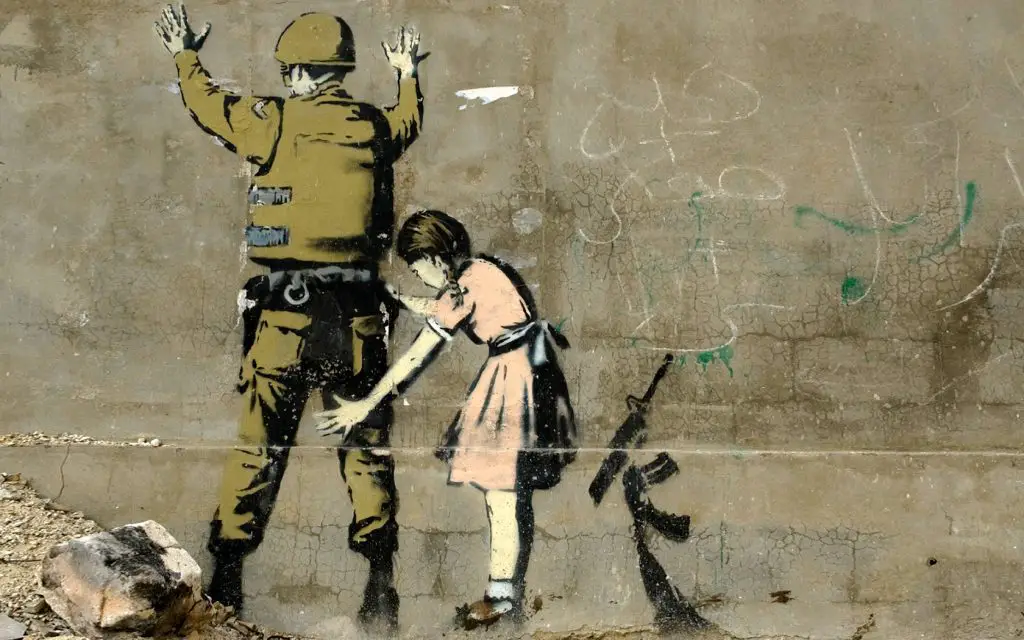
Banksy is perhaps the most famous enigmatic and celebrated graffiti artist of our time, but there’s still so much we don’t know about him.
In this blog post, we’ll uncover some of the most fascinating facts about the artist known as Banksy and his artworks that you may have never heard before.
Affiliate Disclaimer: This post may contain affiliate links, which means I will receive a commission if you make a purchase using these links.
1. Banksy Began His Career as a Graffiti Artist
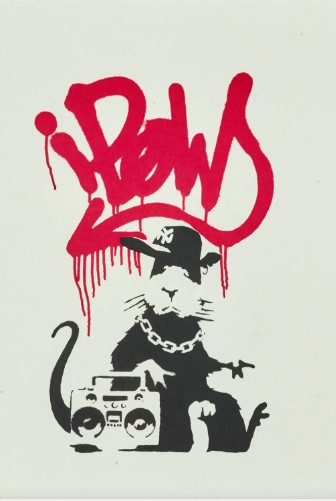
2004
Banksy’s Early Work as a Street Artist
Banksy began his career as a graffiti artist in the late 1980s and early 1990s, with his early work heavily relying on stencils.
He started out by making simple, monochromatic designs for public spaces, often with a political or social message.
His use of stencils allowed him to create his art on a large scale quickly and efficiently, while also adding a sense of anonymity to his work, making it difficult for authorities to track him down.
The complexity of Banksy’s stencils increased as his fame grew. His designs began to incorporate more colors and details, and his messages became more nuanced.
Banksy Graffiti Rat Stencils
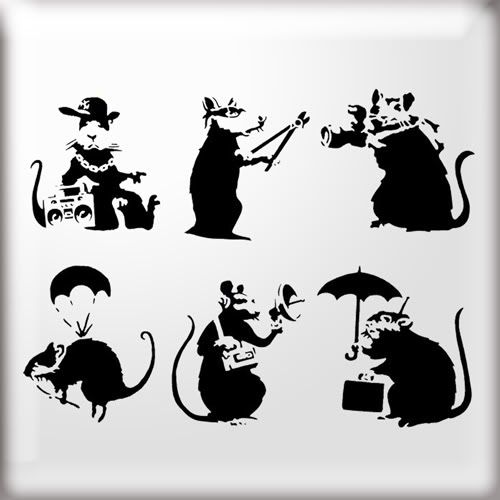
His early notable works included a series of rat stencils that could be found on London’s walls and streets.
These rats frequently carried political messages and were thought to represent the spread of inequality and poverty in urban areas.
Kissing Coppers
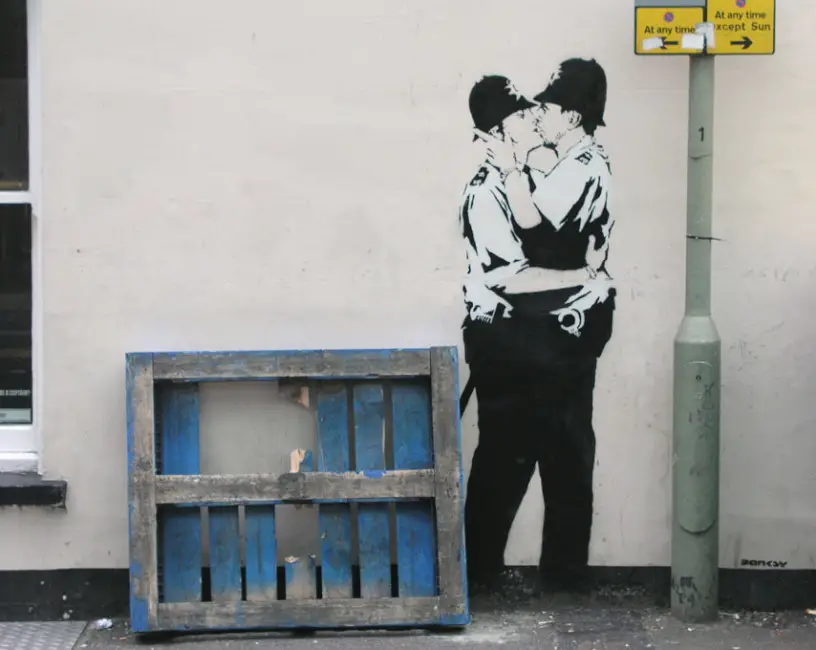
Year: 2004
Location: Brighton, England
Banksy also began to create large-scale works, such as his Kissing Coppers mural in Brighton, which depicted two male cops locked in a tender embrace.
The mural was interpreted as a critique of the police force’s hypocrisy and perceived use of excessive force against minorities.
Overall, Banksy’s early work as a street artist laid the groundwork for the iconic style and themes that have elevated him to the status of one of the world’s most renowned artists.
His use of stencils, political messages, and eye-catching visuals helped him establish himself as a distinct voice in the street art scene, distinguishing him from other artists in his field.
2. His Early Works Shaped His Style and Theme
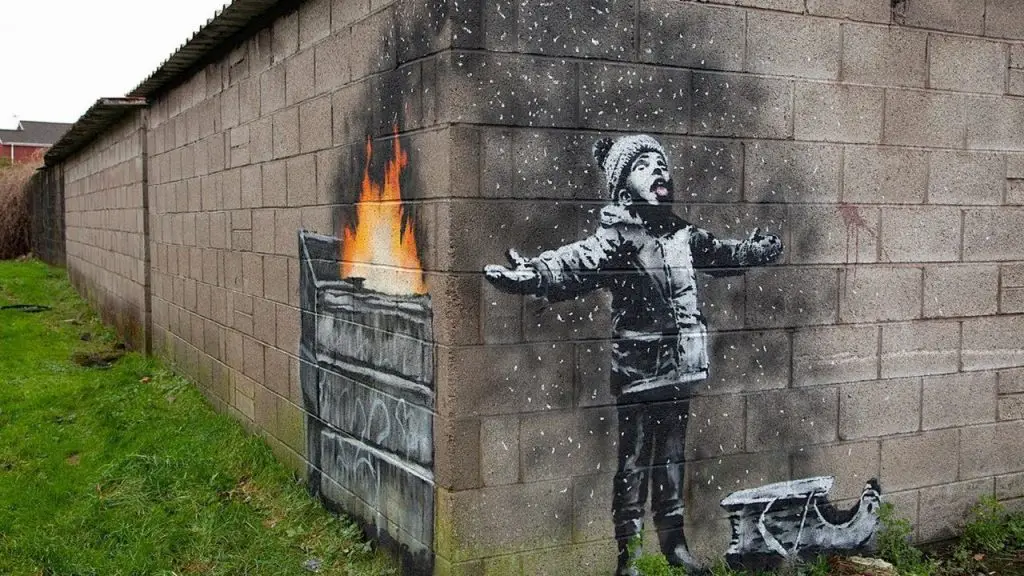
Banksy’s early work as a street artist was instrumental in shaping his distinct style and themes for which he is now known.
The use of stencils in his early work not only allowed him to work quickly and efficiently, but also gave his art a distinct and recognizable style that set him apart from other street artists at the time.
The bold lines and sharp edges of his stencils created eye-catching visuals that helped establish Banksy as a distinct voice in the street art scene.
Furthermore, his early use of monochromatic color schemes helped to emphasize the simplicity and impact of his designs.
Banksy’s early graffiti artwork focused on political and social issues, laying the groundwork for the themes he continues to explore in his art today.
He frequently used his art painted on a wall to protest issues such as poverty, inequality, and government corruption.
This political and social commentary in his early work helped establish Banksy as more than just a creator of visually appealing street art.
3. Works Painted by Banksy Often Contain Political or Social Commentary
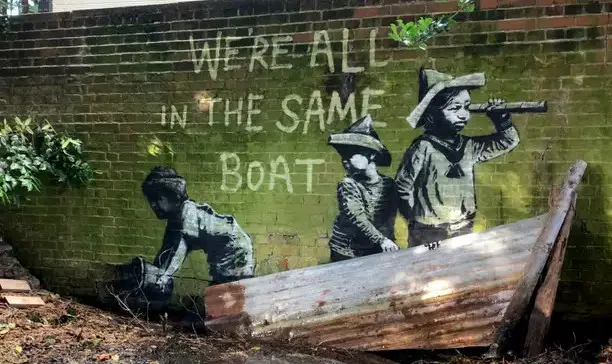
His early works were a social commentary on current events, and his anonymity added a layer of intrigue and mystery to his work, making it more provocative and intellectually stimulating to people.
This helped to pave the way for his later works and the themes he’d address, which would be widely recognized and appreciated by people all over the world.
Overall, Banksy’s early work as a street artist influenced the development of his style and themes. His use of stencils, political and social commentary, and anonymity all contributed to his emergence as a distinct and influential voice in the art world.
Example of a notable early work
Rage the Flower Thrower
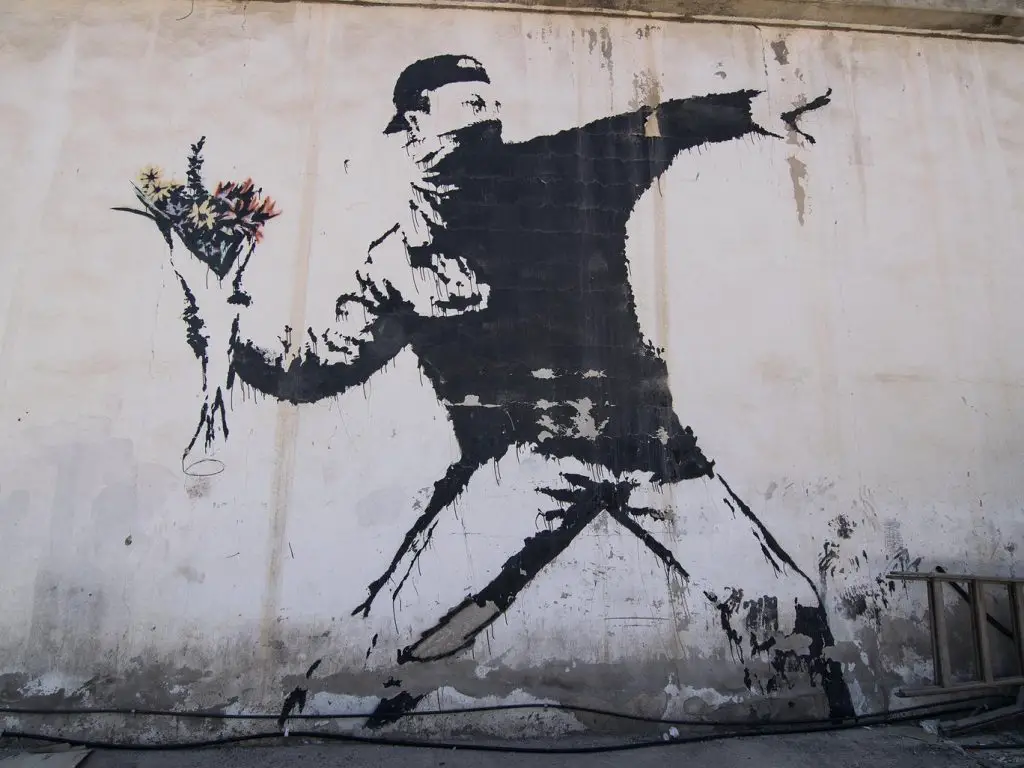
Rage the Flower Thrower, also known as “Thrower,” was one of Banksy’s early works, created in 2003. In the Palestinian territories, it is stencil graffiti depicting a masked figure throwing what appears to be a bouquet of flowers.
The piece was created on the contentious Israeli West Bank barrier that separates Israel and Palestine, and it is one of Banksy’s most iconic and well-known works.
The “Flower Thrower” has been widely interpreted as a parable about the Israeli-Palestinian conflict and the use of violence.
The use of flowers as a weapon implies that the figure is attempting to resist through nonviolence, while the mask represents the artist’s anonymity.
The work’s placement on the West Bank barrier, which has come to symbolize the conflict, provides it with a strong political context. The image appears to reject violence in favor of peaceful resistance, a message that resonated with many people on both sides of the conflict.
This piece had a significant impact on the art world as well as the political sphere; it has been widely reproduced and imitated, and it is still one of Banksy’s most famous painting of all time
One Nation Under CCTV
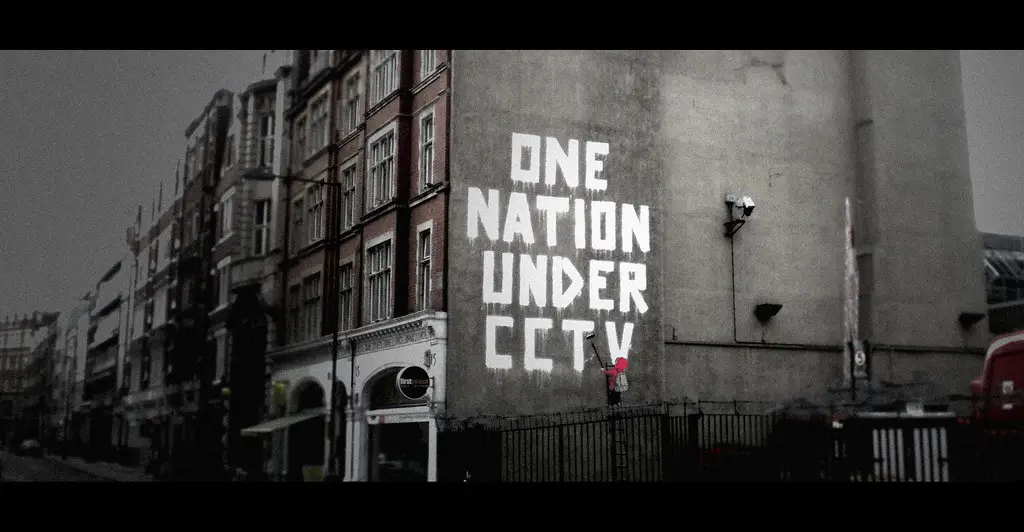
Banksy’s piece One Nation Under CCTV (2007) might be interpreted as a critique of the surveillance culture that has emerged in many modern-day countries.
It is a harsh reminder of the dangers of overreaching governmental authority, with civilians subjected to continual and extensive surveillance.
This work addresses the debate over surveillance, which is firmly based on Foucauldian conceptions of discipline and control.
Balloon with Girl (balloon girl)
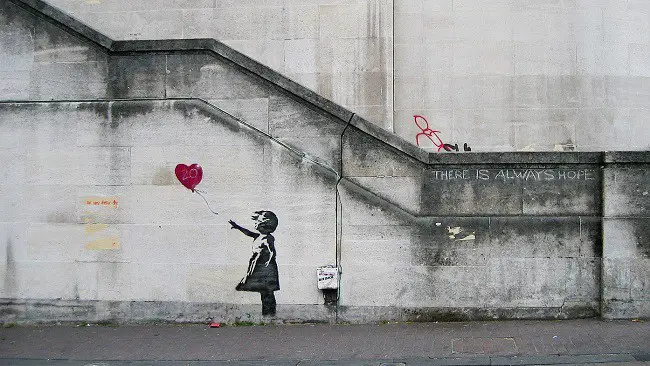
Girl with Balloon (2002) This piece by Banksy, features a young girl reaching for a heart-shaped balloon. It could be seen as a visual representation of the contemporary human condition.
Through the use of subversive art, Banksy critiques the prevailing socio-cultural order, conveying a sense of disillusionment and unrest via his graffiti works.
The image itself illustrates an ambiguous play on notions of hope and despair; the floating balloon symbolizes a potential escape from reality, while its imminent deflation suggests imminent failure.
How Banksy uses Art as a Form of Protest:
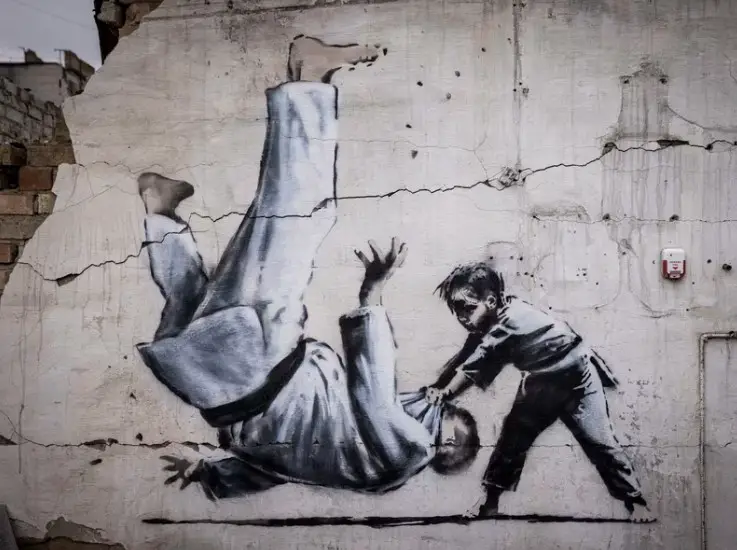
Banksy uses art as a form of protest by creating pieces that challenge the status quo and spark public debate. His work frequently addresses issues like poverty, inequality, and government corruption.
His work is frequently viewed as a commentary on society and political events, using graffiti to deliver a message to a large audience in an unmistakable manner.
Banksy’s anonymity allows him to create art without fear of repercussions, which strengthens and amplifies his message.
4. Banksy’s Work is Recognised Globally
Mild Mild West-Bristol
The works of the anonymous British street artist known as Banksy has achieved an unparalleled level of ubiquity and significance within contemporary art.
Examples of his work have been found in diverse countries around the globe, offering a fascinating glimpse into the transnational reach of this significant figure.
The distinct visual language employed by Banksy has been widely acclaimed for its satire, poignancy, and capacity to provoke discourse on social and political issues.
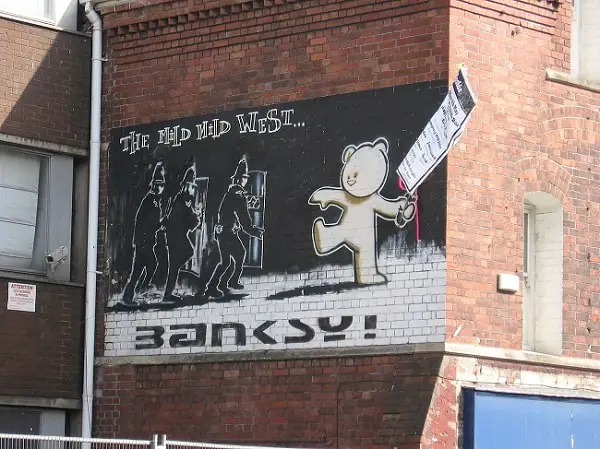
The Steve Jobs Graffiti
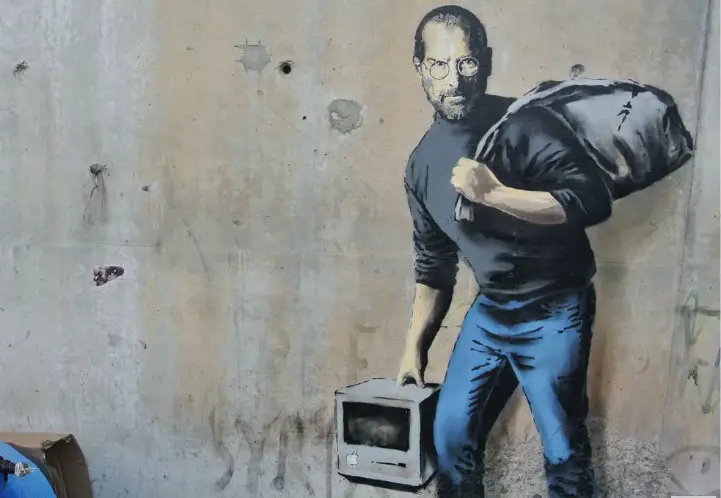
Banksy created several pieces in Calais, France, which is home to the Calais Jungle refugee camp, including “Steve Jobs,” a portrait of the late Apple co-founder depicted as a refugee.
Banksy created several artworks in Australia, including “Kangaroo Rat,” which can be found in Melbourne’s Hosier Lane.
Discussion of the work’s cultural and social contexts in their respective countries:
Banksy’s artworks in various countries are frequently tailored to the local cultural and social context. The “Flower Thrower” mural in the West Bank, for example, refers to the Israeli-Palestinian conflict and the use of violence, whereas the “Steve Jobs” mural in Calais addresses the refugee crisis and immigration issues.
In the United Kingdom, his works reflect a social and political commentary. Banksy’s artworks in Australia reflect societal and cultural concerns.
The Impact and Reception of such Works:
- Banksy’s art has had a significant impact on the art world and society as a whole, with political and social messages.
- They have received extensive media coverage, sparking public debate and discussion.
- Many people have praised Banksy for his ability to use art to protest and draw attention to important issues.
- Some criticize Banksy for what they see as a lack of real-world solutions to the issues he addresses, while others criticize galleries and museums for commercializing and commodifying street art.
- Banksy’s politically and socially charged art has had a profound impact on the art world and society as a whole, and it is still widely discussed and debated.
5. His Identity Remains a Mystery
Banksy’s Anonymity:
- Banksy began creating graffiti art in the late 1990s and early 2000s, and he has maintained a strict level of anonymity since then.
- Banksy has never revealed his true identity, and while some claim to know who he is, he has never confirmed or denied their claims.
- He has used aliases and pseudonyms over the years and has even created a persona for himself to maintain his anonymity.
Attempts to Reveal Banksy’s Identity Failed:
- Despite numerous attempts, Banksy has managed to keep his true identity hidden.
- Some claim to know who Banksy is, but their claims have not been verified.
- Banksy’s anonymity stems in part from his secrecy and caution with who he interacts, as well as his use of advanced technologies to conceal his location and identity.
- Furthermore, he has been active for a long time and has a team of legal and PR professionals to assist him in navigating the publicity, making it difficult for those to obtain any clear information.
6. Banksy’s Anonymity has Impacted the Interpretation and Perception of His Art
- Banksy’s anonymity has had a significant impact on art interpretation and perception.
- Viewers are left to focus solely on the artwork and the message it conveys without knowing who he is or where he is from.
- Banksy’s anonymity has also added a layer of mystery and intrigue to his work, making it more provocative and intellectually stimulating.
- His identity is still unknown, making him a more mythical figure, and inspiring curiosity and interest in his art.
- Furthermore, Banksy’s anonymity allows him to create art without fear of repercussions, which strengthens and amplifies his message.
- It enables him to freely express his opinions without being bound by any identity, adding to the weight of his message.
7. Banksy’s ‘Exit Through the Gift Shop’ won Several Awards
Exit Through the Gift Shop a documentary directed by acclaimed filmmaker Banksy is an interesting and thought-provoking examination of art and culture in our contemporary world.
The film garnered high praise from critics and audiences alike and was honored with multiple awards including an Academy Nomination in 2011:
- 2010, the Toronto Film Critics Association award for Best Documentary.
- 2010, the Washington D.C. Area Film Critics Association Award for Best Documentary
- 2011, the Independent Spirit Award for Best Documentary Feature
Here is a full list of Banksy’s awards and nominations for Exit Through the Gift Shop.
Watch the full documentary below:
8. Works Produced by Banksy Connect and Resonate Globally
Banksy’s art connects and resonates with people all over the world because it addresses universal themes like inequality, poverty, and political corruption, all of which are relevant to people everywhere.
His art frequently highlights the human condition, which anyone, regardless of background or location, can relate to. Banksy’s art has a distinct style that is instantly recognizable, allowing him to connect with people all over the world.
Finally, Banksy’s art has the ability to cross borders and speak to people of all backgrounds and locations.
It has the ability to communicate ideas, feelings, and messages that resonate with people all over the world, which is why people are still interested in his art.
9. The Increased Value of Banksy’s Work
Examples of Banksy’s High Priced works:
- “Girl with Balloon” (2006) was auctioned off for more than $1.4 million in 2018.
- In 2008, “Keep It Spotless” (2007) sold for more than $1.8 million at Sotheby’s.
- In 2019, Sotheby’s auctioned off “Devolved Parliament” (2009) for more than $12 million.
Reasons why Banksy’s art has become so valuable:
Banksy’s art has seen an unprecedented surge in value due to its unique blend of visual aesthetics and social commentary:
- For starters, it has become incredibly valuable because of its esoteric character; the mystery surrounding the artist’s identity has made Banksy’s works a source of intrigue for many people.
- He does not create art for sale in the traditional sense contributing to his work’s scarcity.
- As Banksy’s fame and reputation grew, his art has become more valuable.
- Its highly charged political statements, frequently delivered through non-conformist means such as graffiti and stencils, have added a new element of complexity to traditional creative expression methods.
- This combination has endeared Banksy’s work to the modern generation, making it instantly recognizable and increasingly coveted by major art collectors around the world.
10. Banksy’s Work has been Featured in Museums and Galleries
Notable Exhibitions by Banksy:
- Severnshed, 2000: The artwork received mixed reactions, it included a number of stencil and acrylic works on canvas, including the Simple Intelligence Testing series
- Existencillism 2002: this Pun-Filled exhibition was Banksy’s debut in the United States.
- Turf War, 2003: Turf War was Banksy’s first significant exhibition, which took place in London.
- Crude Oils, 2005: Banksy showcased his work in a small shop at 100 Westbourne Grove in Notting Hill for a week.
- Barely Legal, 2006: was hosted at a Los Angeles industrial warehouse.
- Banksy v. Bristol Museum, 2009: Banksy transformed the museum’s main entrance into a sculpture hall with over 100 works of art, 78 of which were new.
- Dismaland: Bemusement Park, 2015: this exhibition featured more than visual art, it also saw participatory performances and concerts by artists like Pussy Riot and De La Soul.
- Walled Off Hotel 2017: held 10-room boutique hotel located a stone’s throw away from Israel’s West Bank
Gross Domestic Product, 2019: with this exhibition, Banksy launched a new type of creative endeavor in the autumn of 2019, commencing with the launching of Gross Domestic Product, a shop in Croydon.
11. Banksy Legal Issues
Banksy has been the subject of numerous legal issues.
His diverse artistic output has consistently sparked debate among the public and legal authorities, resulting in multiple judicial proceedings that have tested the boundaries of both copyright law and freedom of expression:
- The ownership and copyright of Banksy’s work have been a point of contention. Banksy’s art is frequently created on private property without the permission of the owner, raising concerns about who owns the rights to the art.
- Some argue that the artist owns the copyright to the work, while others argue that the property owner owns the artwork. Banksy’s use of anonymity added another layer of complication to the situation, making it difficult to know who to contact for copyright clearance or commercial use of his work.
- These legal issues have ramifications for the entire street art community. Street art is frequently regarded as a form of self-expression and a means for marginalized communities to share their stories and points of view.
- Banksy and other street artists’ ability to create and share their work has been hampered by legal challenges, which have chilled free expression in general.
These issues surrounding copyright and ownership have made it difficult for street artists to monetize their work and make a living, resulting in significantly reduced financial resources for the community.
Although street art is not as respected as traditional art, it remains a culturally significant form of creative expression that continues to evolve and develop.
12. Banksy Art Activism and Stunts
Throughout his career, Banksy has been a part of several notable art activism and stunts.
The most notable one occurred in the British Museum in London in 2005.
Santa’s Ghetto was a “squat art concept store” that opened each Christmas from 2002 to 2007 in various locations across London (save for 2007, when he took the show to Bethlehem).
It was a collective show that included all of the artists represented by Pictures on Walls. Banksy produced some of his most famous prints, editions, and originals here.
Final Thoughts on Banksy’s Artworks
Finally, Banksy’s artworks are not only visually appealing, but they also convey powerful messages that resonate with people from all walks of life.
Banksy has had a significant impact on the art world and society as a whole, with his controversial street art and thought-provoking stunts.
We’ve uncovered 12 fascinating facts about Banksy’s art that you may not have known, such as his use of satire, political activism, and the mystery surrounding his true identity, in this blog.
He has demonstrated that art can be used for more than just self-expression; it can also be used to effect social change. His works continue to raise awareness about issues such as poverty, war, and consumerism, as well as challenge us to think critically about the world around us.
Despite the mystery surrounding his identity, the impact of his artworks is undeniable. He rose to prominence in the contemporary art world, and his works are still relevant today.



Leave a Reply